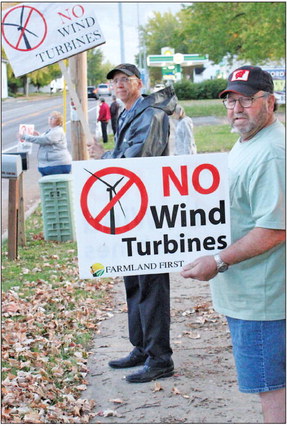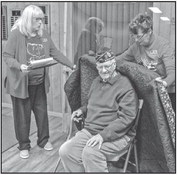Alliant Energy proposes wind turbine project


Company meets with potential landowners for contract leases
Alliant Energy in Madison is developing a potential 100 megawatt wind energy project in southwestern Marathon County. The company mailed letters to landowners in the towns of Day, Cleveland, Eau Pleine, Green Valley and McMillan inviting them to attend last Wednesday’s informational session at the Stratford VFW clubhouse.
The company’s wind energy project staff met with potential participating landowners who attended the meeting to answer their questions about the wind turbine project. Alliant Energy staff gave attendees copies of the contract to lease their property so they could either sign the agreement on-site or take the contract home to review before they sign it. The company compensates the landowner per acre of land used for wind turbines each year during the 30- to 40-year contract.
Alliant Energy has not used eminent domain for its renewable energy projects and it doesn’t plan to do so in the future, therefore it needs landowners to voluntarily choose to sign a property lease to have wind turbines constructed.
Rick Zimmerman, manager of resource development at Alliant Energy, said the wind energy project in southeastern Marathon County consists of building 20 to 30 wind turbines. He said one acre to 1.5 acres of land will be used for each wind turbine, which includes the road Alliant Energy will build to reach the wind turbine on the landowner’s property.
“We only have access to the land that the owner wants to include in the lease,” he said. “We cannot force a landowner to remove any structures or infrastructure that resides on their property.”
Zimmerman said Alliant Energy is fine with a landowner hiring a personal attorney to review the contract lease. He said although legal fee reimbursement is not mentioned in the contract, Alliant Energy will pay for the landowner’s attorney fees.
“In discussions with the landowner, we will inform them that we will reimburse reasonable legal fees at contract execution,” he said. “Typical legal fees generally range from $500 to $1,500. There is some flexibility on the limit.”
Zimmerman said there is a confidentiality clause in Alliant Energy’s contract that prevents a signed landowner from discussing the commercial terms and design details of the agreement with other people; however, there is not a clause that prevents a landowner from telling others that he or she signed a contract with Alliant Energy.
Alliant Energy’s potential southwestern Marathon County wind project overview sheet that was handed out to attendees at last Wednesday’s informational session in Stratford states this potential project is part of Alliant Energy’s Clean Energy Blueprint, a strategic roadmap to cost-effectively accelerate renewable energy development in Wisconsin and reduce carbon emissions. The overview says this project will positively impact the environment and generate enough clean, zero-cost energy to power nearly 30,000 homes each year.
The company’s Frequently Asked Questions flyer on wind energy states that communities receive significant financial benefits through the Wisconsin Shared Revenue Program, which provides annual payments from the state to local communities that host generation resources. For example, the flyer says participating townships will split $215,000 each year, based on the number of turbines in each township, from the state. Marathon County would receive approximately $283,000 each year from the state. The annual payments continue for the lifetime of the project.
Trine Spindler created the town of Day wind turbine update Facebook page and she organized an informational meeting about wind turbines on May 8 at Zion Lutheran Church in Stratford. She also organized a peaceful protest last Wednesday outside the Stratford VFW clubhouse to show potential participating landowners that there is local opposition to the construction of wind turbines.
She and her husband, Kobey Spindler, own and operate a Jersey dairy farm in the town of Day that utilizes robots milking 140 cows. They are members of Farmland First, a grassroots organization protecting landowners in Clark and Marathon counties. The Spindler couple would never lease its farmland to Alliant Energy for wind turbines and they are hoping their neighbors don’t sign leases either. They are concerned about the vision of large wind turbines across the countryside.
“I love the beautiful nature we have in central Wisconsin and I want to keep it,” Trine Spindler said.
The couple is also concerned about the potential of stray voltage on their dairy farm that could occur from nearby wind turbines. Stray voltage consists of electrical current in surfaces animals contact. Stray voltage could affect animals’ health and cause dairy cows to produce less milk.
Zimmerman said Alliant Energy is happy to provide support to landowners on this matter.
“We understand some landowners may feel this is a concern, as stray voltage is a complex topic,” he said. “Alliant Energy continues to navigate stray voltage concerns and works diligently to avoid issues for our communities that we serve. This project will be no different. The proposed wind project will be directly connected to the transmission grid and Alliant Energy anticipates having no stray voltage issues resulting from the wind farm. Additionally, Alliant Energy will perform pre- and post-construction stray voltage testing at all dairy and confined animal operations within a half mile of a turbine.”
More information regarding stray voltage as well as how to book a free on-site consultation with Alliant Agricultural Representatives can be found at https://www.alliantenergy. com/communitysupportandsafety/ safety/safetyonthefarm/strayvoltage.
A few of the other peaceful protesters last Wednesday mentioned they are concerned about Alliant Energy not allowing them to hunt on land they lease to the company for wind turbines. Zimmerman debunked their concerns.
“We do not have the authority to prevent the landowner from hunting on the property,” he said. “We will work with the landowner and often request the landowner not hunt nearby during the time we are constructing the turbine, for safety reasons.”
The following is Alliant Energy’s exact contract language: ‘To the extent that Grantor undertakes any hunting activities at the Premises, or allows any other parties to undertake any hunting activities at the Premises, Grantor and Grantee shall work together in good faith to ensure the safety of Grantee’s Wind Facilities and employees, contractors, and agents.’ ” Peaceful protestors were also concerned about Alliant Energy possibly not removing the wind turbines off their land after the contract ends. Alliant Energy states in its Frequently Asked Questions flyer that when wind turbines reach the end of their life, the turbine is decommissioned and removed from the site. All projects have a decommissioning plan submitted to the permitting authority.
The flyer also states that wind turbine components are nearly 100 percent recyclable. Major advances are being made in blade recycling that will likely have a major impact on Alliant Energy’s recycling options when it is ready to decommission its wind projects.
Alliant Energy contracts with Ulteig to lease the SWID Law Offices space in downtown Stratford to meet with potential participating landowners who are uncomfortable meeting on their property. The local Alliant Energy representatives’ business contact cards are posted on the front window of the office so potential participating landowners can call them to schedule a meeting. Landowners can contact Ryan McMakin of Ulteig at 720-272-5756 (cell).
Julie Garrett, community engagement partner at Alliant Energy, announced that Newsweek recently named Alliant Energy on its inaugural Word’s Most Trustworthy Companies list.
Zimmerman said Alliant Energy is in the developmental stage of its potential 100 megawatt wind energy project in southwestern Marathon County. He said once the company secures leases from the number of landowners it needs, then they will erect a meteorological tower to measure the wind speed. It takes three to six years to complete the development process before construction can begin.
 Rick Zimmerman
Rick Zimmerman


